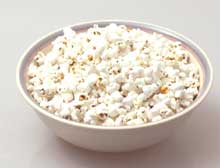Popcorn

Tens of thousands of years before there were movies, there was popcorn.
Stone Age Snack?Archaeologists have found 80,000-year-old corn pollen below Mexico City. Because this pollen is almost exactly the same as modern popcorn pollen, researchers believe that "cave people" most likely had popcorn.
Popcorn probably grew first in Mexico, though it was also used in China and India hundreds of years before Columbus reached the Americas.
Tasty FossilsThe oldest popcorn ever found was discovered in the "Bat Cave" of central New Mexico. It is thought to be about 5,600 years old. In tombs in Peru, archaeologists found ancient kernels of popcorn that are so well preserved that they can still pop.
Sometimes, conditions can preserve ancient popcorn so perfectly that it still looks fluffy and white when the dust is blown off of it. In a cave in southern Utah, researchers found surprisingly fresh-looking 1,000-year-old popcorn.
Popcorn was probably an important part of life in the ancient Americas. On a 1,700-year-old painted funeral urn found in Mexico, a corn god is shown wearing a headdress of popcorn. Decorated popcorn poppers from around the same time have been found in Peru.
An Explosive DiscoveryEuropeans learned about popcorn from Native Americans. When Cortes invaded Mexico, and when Columbus arrived in the West Indies, each saw natives eating popcorn, as well as using it in necklaces and headdresses.
Native Americans brought a bag of popped corn to the first Thanksgiving. A common way to eat popcorn at that time was to hold an oiled ear on a stick over the fire, then chew the popped kernels off it. Natives throughout the Americas also made a popcorn beer. Some made popcorn soup.
After learning about the fluffy food, colonists began enjoying the first puffed breakfast cereal—a bowl of popcorn, served with cream or milk.
Popcorn and Americans: True LovePopcorn was very popular in the United States from the late 19th century through the middle of the 20th century. It was available in parks, from street vendors, and near theaters.
During World War II, when sugar was rationed, Americans changed their snacking habits—they ate three times as much popcorn as they had before. Perhaps the favorite place to eat popcorn was at the movies. When television took off in the 1950s, popcorn sales dropped for a while.
Today, the average American eats nearly 70 quarts of popcorn a year. But the United States isn't just a land of popcorn lovers—it's also the land of popcorn. Most of the world now gets its popcorn from Nebraska and Indiana.
Pop SecretA popcorn kernel is actually a seed. Like other seeds, inside it has a tiny plant embryo (a life form in its earliest phase). The embryo is surrounded by soft, starchy material that would give the embryo energy for growing into a plant. A hard, glossy shell protects the outside of the seed.
The soft, starchy material holds some water. When the kernel is heated to a high heat (400 degrees F), the water inside the kernel turns into steam. The pressure from the steam causes the kernel to explode. The soft starch inside bursts out at about 40 times its original size, turning the kernel inside out. This creates the fluffy white area of a popped kernel.
The ideal popcorn kernel contains about 14 percent moisture. If the popcorn is much drier, it will not pop. Popcorn kernels should be kept in a tightly sealed jar so that they will not dry out.

